We both slept pretty well last night even with the lower oxygen levels at this altitude. Stephanie had not worn the cannula all night for getting supplemental oxygen from the concentrator, she had just worn it a couple of hours when she first went to sleep. She was feeling much better today, and I felt fine other than we both had dull headaches, one of the symptoms of being at a high altitude.
We got up at 7:15 AM, we try to give ourselves about two hours in the morning to get ready, eat breakfast, and relax a little before we have to go on an excursion. It is not great to say it, but we also need some extra “potty” time in the morning on this trip, none of the food seems to sit well on our stomachs, and we are eating a lot of different things, especially at our lunches out on the excursions. Plus, after trying to hydrate at the higher altitude, as well as some coffee and diet coke in the mornings, we have to be careful about needing to use the restroom on the excursions, we always seem to have a long drive after we first get on the bus before we get to our first destination, get off the bus, and walk to somewhere with a restroom. It can be a couple of hours after we leave the room, and we can’t make these calls to change plans to go to a restroom on our own when traveling with a group, and that is an adjustment for us since we normally travel on our own.
We headed to the breakfast buffet which has been the case for all of these hotels, the spread is fantastic. However, there are just a lot of things we don’t normally eat for breakfast, or even consider eating for breakfast, and we are afraid of the consequences afterward if we try them, especially with all day excursions away from the room and a restroom!.
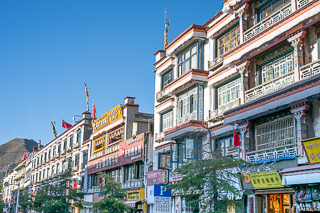
We met our group down in the lobby at 9:00 AM and boarded our bus for today’s excursion. This morning, we are visiting the Jokhang Temple in Lhasa, and the Ani Tsankhung Nunnery. Later tonight, after having a couple of hours to rest a bit at the hotel, we are going to a buffet dinner with a traditional Tibetan dancing performance afterward, so we have a very full day.
We had a short bus ride to the Jokhang Temple, about 10 minutes. The bus had to drop us off about six blocks from the Temple, and we had to walk there along a street full of stores, which were very interesting and colorful. We made it to the entrance to the temple and we had to go through security. They were just using an x-ray machine to scan the bags, there was no metal detector for us to walk through.
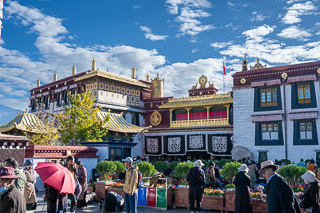
We all entered a large square that was in front of the temple. As we walked toward the temple, we could see a lot of people walking right in front of it. My initial reaction was that these were all tour groups going to the temple, but I was wrong. Our guide told us that these people were making clockwise circles around the temple. According to information we found online this is the reason.
“The Tibetan word kora means the act of walking around or circumambulating a sacred place or object. Tibetan Buddhists do kora as a form of pilgrimage and meditation. Circumambulation of temples or deity images is an integral part of Tibetan Buddhist devotional practice.”
There were hundreds of people walking around the temple. Our guide told us that they always walk on a clockwise direction, and only do an odd number of circles.

There were also many people prostrating themselves in front of the temple and some were doing this as they did the circles all the way around the temple. Most people had wooden paddles on their hands and would use the paddles to slide down and lay fully prostrated with their forehead on the ground and then rise up, take two steps forward that approximated their body length, and then do the same thing again.
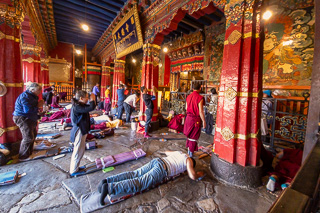
The paddles were a way to protect their hands, and to be able to slide them along the stone paving. Our guide told us that her father had done this all the way from his village many kilometers away when he first came to Lhasa many years ago, and people still do this long distance form of a pilgrimage, and it may take months to travel this way on foot, prostrating each body length as they go.
We had to get into a line and wait for our guide to get the tickets for our group. There was some confusion and we were stuck in a small narrow passageway at the entrance, and other people going inside the temple were trying to pass by. Our guide finally made her way to the attendant and had to show some paperwork to him, and then we could all pass with our individual tickets. We were not sure why there had been a delay, but it caused outer groups to have to squeeze by us in the narrow passageway.
There were many people on the outside of the fencing who were prostrating themselves in a stationary location, continuously moving up and down many times as a way to show respect and meditation. Our guide said her parents do this up to 200 times in the morning as part of their daily worship.

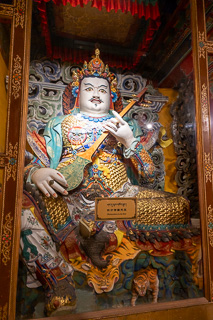
We entered the open square outside of the temple and took some photos. After entering the temple itself, we were not allowed to take photos as a sign of respect for the temple.
Inside were many different Buddhas, each representing a different aspect of their religion. Some were for protection, some were for health, some were for long life, and there were many others. It was very interesting to see. They also had Yak Butter that they used in large metal containers on pedestals with several wicks in it and they burned it as candles, using the Yak Butter instead of wax.
There was a large assembly area for the monks to meet and meditate in the mornings. There were also several large models of ancient temples that were adorned with brass or gold.
It was very interesting to see, and we will do a separate post later that explains some of what we learned about Tibetan Buddhism.

It was really crowded in the temple, most people were there for worship and not tourism, but there were several other tour groups there from China. On this entire journey, we have been the only non-Asian tour groups we have seen in China. We have seen some small groups or even families of westerners, but they seem to be traveling on their own. Many were not speaking English, they may have been from Europe.
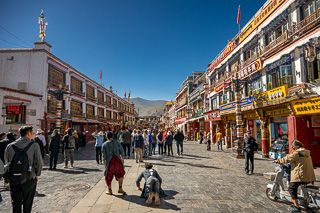
After we left the temple, we headed outside to the square. We were given some time to explore on our own, and the suggestion was to do one circle around the temple and to visit some of the stores along the way. It was a really large circle, probably close to 1.5 km in total distance.
The walk is really along a street that happens to be the only way around the temple, it was a much longer walk that just the size of the temple grounds, but it was the route to make the circle.
There were pilgrims and worshipers continuously walking around the temple, and as we said before, several doing these circle prostrating themselves as they went, one body length at a time..
Even though we were on our own, our local guide and Michael were walking along with us. We were shown a shop that sold items made by the Buddhist nuns at the nearby nunnery, and they were authentic, and the proceeds went to support the nunnery, which we were visiting later today. We headed up to the third level of the building with the store in it and we had great views of the Potala Palace off in the distance which we will visit tomorrow.
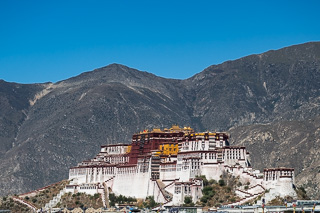 The store was on the second floor, but we did not spend much time there. We were able to use the restroom, but it was not a great experience. There were four stalls and it was all shared gender. Of course, all of the stalls were for squatting, there were no western toilets, and they were not that clean, at least they did not smell that clean. It was not an issue for me, I only had to go using the small hole on the floor, but for women or anyone going #2, squatting was the only method here.
The store was on the second floor, but we did not spend much time there. We were able to use the restroom, but it was not a great experience. There were four stalls and it was all shared gender. Of course, all of the stalls were for squatting, there were no western toilets, and they were not that clean, at least they did not smell that clean. It was not an issue for me, I only had to go using the small hole on the floor, but for women or anyone going #2, squatting was the only method here.
We headed outside to continue our one circle around the temple, mostly to visit some stores along the way, but now we had to get back out to the front. We stopped by one store and Stephanie bought some knotted string items that also had a red Chinese Knot tied on the top. Each color of the string used represents the phases of the Tibetan beliefs of nature, for example, blue is for purity and healing.
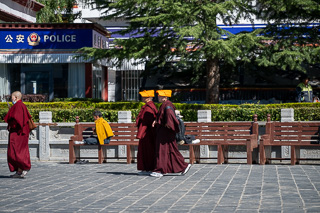
Once were were done there, we continued our walk around the circle. There was a special area in the stone pavement that was about four feet wide, and the stones for this part of the walkway were much smoother than the more cobbled stones of the rest of the wide walkway. These smoother stone areas were for the people that were making the circle by prostrating themselves for each body length they went. They needed a smoother surface to slide their hands outward, wearing the wooden pads on their hands. It was a long way to walk, much less prostrating themselves for the entire distance around the temple.
We walked part of the way around with our Guide Michael and he told us a lot of information as we went along.
Stephanie stopped at a few more shops, but I continued on to the meeting area in the square and sat on a bench in the shade to rest my legs. Of course, walking a lot at 12,000 feet in elevation was not easy either, and this was our first day doing a lot at this altitude.
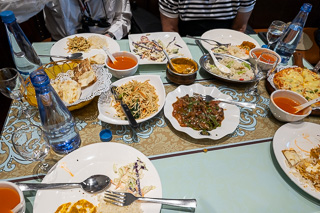
The group all met back at the square and we had to walk several blocks to a point where we could meet our bus. From here, we headed to a local restaurant called Namaste to eat some lunch. The restaurant was good, it had a lot of options, they served everything in serving bowls at each table, and we served our plates from the large bowls. There were quite a few different dishes to eat, and we sampled many of them, but some did not look that appetizing. In the end, it was a good Tibetan meal, but there was a lot of food left over, no one seemed to want to eat a lot of any particular dish, the food was just different.

The next stop for today was the Ani Tsankhung Nunnery. It is similar to a convent in some Christian denominations, especially the Catholic Church. There were about 150 nuns at this nunnery, and they have a similar appearance to monks, their heads are shaved and they wear the same type robes. It would be difficult to distinguish them from the men, all you can really see is their shaved heads.
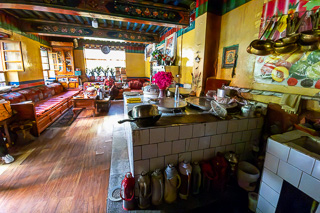
We had to walk a couple of blocks from there the bus dropped us off to get to the entrance to the nunnery. On the way, we passed by a school. The children are usually in school from about 8:00 AM to around 6:00 PM every day, much longer than US school days.
We climbed some steps at the entrance to the nunnery and entered a courtyard. Our guide went to get our tickets, tourism is one of the ways the nunnery can generate income to help cover their expenses.
We then went up some more steps to the assembly area, each temple, monastery and nunnery has an assembly area where they can congregate for prayer and discussions. These are typically not places where photographs are allowed, but we could take photos at the nunnery. Our guide had some cousins at the nunnery, but she did not see them today. Then we visited the kitchen area.
There was also a small prayer area, similar to a chapel in the Christian faith, and it was filled with various small buddhas and other decorative items.
There was not a lot to see here, but it was interesting.

We headed back the same way to our bus, stopping by a couple of streets along the way. One store had several large cheese blocks all made from Yak milk. The Yak is similar to a cow, but has longer hair and is slightly larger. We learned that the wild Yaks are much larger than the domesticated Yaks and that sometimes the farmers allow their female yaks to go up into the mountains to breed with the larger wild yaks to increase their size. The yak is the most revered of the animals here in Tibet, they are a source of many of their needs, cheese, butter, and meat.

Since there are not many areas for farming at this altitude, and since it is very dry here, they do not have much area for raising crops, so their main diet is Yak meat and lamb. Some Buddhists are vegan, but Tibetan Buddhists eat meat because of the inability to raise many vegetables at the altitude. They do plant a lot of Barley and use it for many things, including making beer.
There was also a store with traditional Tibetan dress items including some interesting hats with fur. The prices were not bad, but there was not much point in purchasing anything, when would we wear it at home?

Once we arrived back at the bus, we drove for several minutes back to our hotel, the Shangri-La Hotel. Stephanie and a couple of other guests we have met, Susie, and her husband Michael and Jill, and her husband Pat, all walked down to a store to find some diet cokes. The hotel had regular Coke in the hotel restaurant at dinner, and sometimes Coke Zero, but not at breakfast when Stephanie wanted one. I headed back to the room to try and work on the blog and to rest my hip.
They were successful in their mission to find the Diet Coke, or maybe they were Coke Zero, it is hard to tell from the cans, all the writing is in Chinese of course!
We had about 2.5 hours to rest before we were going to meet again in the lobby to ride to a restaurant that also has a Tibetan Dance Show. We just stayed i9n the room and rested, still trying to adjust to the altitude. We have been taking our altitude medicine twice a day, and hope it is helping us to adjust.
I continued to work on the blog and Stephanie watched the movie Monuments Men on the TV, we are surprised we get one movie channel in English, along with CNN. CNN is too repetitive to watch for very long.
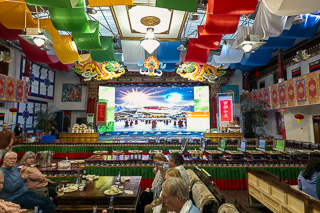
At 5:00 PM, we all met in the lobby of the hotel and boarded our bus for a 40-minute ride to the dinner and dance show. We arrived in a smaller town which was described as a suburb of Lhasa. It took a while to get here, but it was not that far of a distance, there was some traffic and the roads have low speed limits.
The restaurant was very large inside, and there were areas divided into sections with couches and two large square tables. Our little troupe of six all sat at one table, and it was a little tight getting the six of us together, but manageable. It looked like the normal setup was for four people at a table, but we sat there on each side.
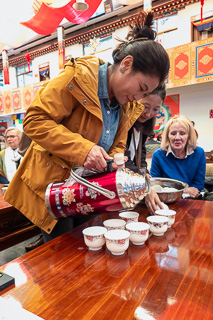
The other table in our area had seating on three sides, so it would have been better for the six of us, but no one noticed that when we first sat down, and then that table was quickly occupied by some others in our group. We are still traveling with three different groups from Viking, with 22 people in each group, so the restaurant ended up being full.
The first item served at the dinner by our local guide was a traditional butter tea. It tasted like it sounds. It seemed more butter tasting than tea tasting. It is a drink that the Tibetan people have every morning, and the butter in the tea helps keep their skin from getting too dry at this high altitude, there is hardly any humidity. No one in our small group that tried it particularly liked the butter tea, and no one finished their small serving.
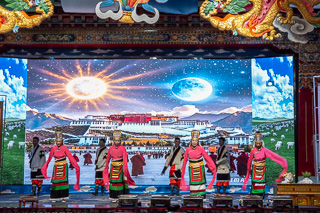
There was a large buffet and once it opened, everyone headed to get their food. Our group waited for the crowd to die down. Once again, there were some traditional Tibetan foods being served, some were spicy and others were just not that appetizing looking. One dish was Yak meat, but it was raw and no one wanted to try it for fear of gastric issues. We were not told if it was prepared like a ceviche, and that there were acids to “cook” the meat, so we assumed it was really raw meat. It was diced up into really small pieces.
After dinner, there was a show featuring different dances from the various areas in Tibet. Each area had different traditions, so they had different dances and traditional costumes depending on their location, typically described by the four compass directions, north, south, east, and west Tibet.
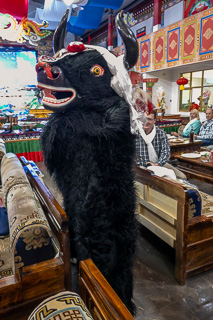
It was interesting to see the different dress and dances, and at the end, there were people dressed up in two Yak costumes that paraded through the seating area, one black and the other was white. That was a lot of fun, they were interacting with the audience as they paraded up and down the aisles.
On a side note, the Yak are typically three colors, black, white, or golden/brown colored. The black is by far the most dominant color. The price of a yak varies based on the color, and since black is dominant, it is the cheapest. and the golden/brown is the most expensive. it is because the hide of the brown Yak is more valuable for its color. Of course, the meat is all the same.
After the show, we boarded our bus for the 40-minute ride back to the hotel, arriving after dark. Everyone seemed tired, it had been a long day at the 12,000-foot elevation, and it take a toll on your stamina.
Tomorrow we have a really difficult day physically, we have to climb a lot of steps up to the Potala Palace, around 360 steps in total just to go up to the top of the palace, and of course, a similar number downward.
We did not stay up long, we retired at about 9:30 PM.
Leave a Reply